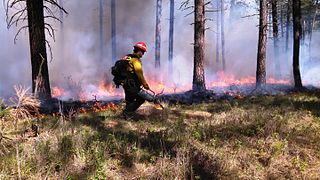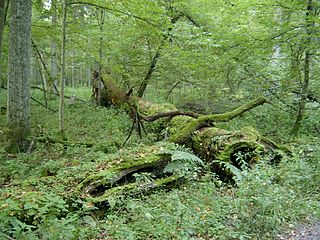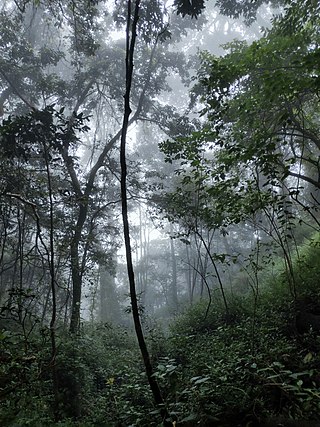Related Research Articles

Forestry is the science and craft of creating, managing, planting, using, conserving and repairing forests and woodlands for associated resources for human and environmental benefits. Forestry is practiced in plantations and natural stands. The science of forestry has elements that belong to the biological, physical, social, political and managerial sciences. Forest management plays an essential role in the creation and modification of habitats and affects ecosystem services provisioning.

Logging is the process of cutting, processing, and moving trees to a location for transport. It may include skidding, on-site processing, and loading of trees or logs onto trucks or skeleton cars. In forestry, the term logging is sometimes used narrowly to describe the logistics of moving wood from the stump to somewhere outside the forest, usually a sawmill or a lumber yard. In common usage, however, the term may cover a range of forestry or silviculture activities.
Fitzroya is a monotypic genus in the cypress family. The single living species, Fitzroya cupressoides, is a tall, long-lived conifer native to the Andes mountains and coastal regions of southern Chile, and only to the Argentine Andes, where it is an important member of the Valdivian temperate forests. Common names include alerce, lahuén, and Patagonian cypress. The genus was named in honour of Robert FitzRoy.

A controlled or prescribed (Rx) burn is the practice of intentionally setting a fire to change the assemblage of vegetation and decaying material in a landscape. The purpose could be for forest management, ecological restoration, land clearing or wildfire fuel management. A controlled burn may also refer to the intentional burning of slash and fuels through burn piles. Controlled burns may also be referred to as hazard reduction burning, backfire, swailing or a burn-off. In industrialized countries, controlled burning regulations and permits are usually overseen by fire control authorities.

Coarse woody debris (CWD) or coarse woody habitat (CWH) refers to fallen dead trees and the remains of large branches on the ground in forests and in rivers or wetlands. A dead standing tree – known as a snag – provides many of the same functions as coarse woody debris. The minimum size required for woody debris to be defined as "coarse" varies by author, ranging from 2.5–20 cm (1–8 in) in diameter.
Silviculture is the practice of controlling the growth, composition/structure, as well as quality of forests to meet values and needs, specifically timber production.

Fire ecology is a scientific discipline concerned with the effects of fire on natural ecosystems. Many ecosystems, particularly prairie, savanna, chaparral and coniferous forests, have evolved with fire as an essential contributor to habitat vitality and renewal. Many plant species in fire-affected environments use fire to germinate, establish, or to reproduce. Wildfire suppression not only endangers these species, but also the animals that depend upon them.
Articles on forestry topics include:.

The Biscuit Fire was a massive wildfire in 2002 that burned nearly 500,000 acres in the Rogue River–Siskiyou National Forest, in southern Oregon and northern California, in the Western United States. The fire was named after Biscuit Creek in southern Oregon. The Biscuit Fire was the second-largest wildfire in the modern post-1900 history of Oregon. Oregon's largest fires are actually believed to have taken place in the 1800s. The Silverton Fire of 1865 is listed as Oregon's largest at over 900,000 acres. The Biscuit Fire area is subject to warm, dry winds known as the Brookings effect, driven by high pressure over the Great Basin. The fire re-burned portions of the 1987 Silver Fire, and much of its area was re-burned in the 2017 Chetco Bar Fire.

Populus tremuloides is a deciduous tree native to cooler areas of North America, one of several species referred to by the common name aspen. It is commonly called quaking aspen, trembling aspen, American aspen, mountain or golden aspen, trembling poplar, white poplar, and popple, as well as others. The trees have tall trunks, up to 25 metres tall, with smooth pale bark, scarred with black. The glossy green leaves, dull beneath, become golden to yellow, rarely red, in autumn. The species often propagates through its roots to form large clonal groves originating from a shared root system. These roots are not rhizomes, as new growth develops from adventitious buds on the parent root system.

Forest management is a branch of forestry concerned with overall administrative, legal, economic, and social aspects, as well as scientific and technical aspects, such as silviculture, forest protection, and forest regulation. This includes management for timber, aesthetics, recreation, urban values, water, wildlife, inland and nearshore fisheries, wood products, plant genetic resources, and other forest resource values. Management objectives can be for conservation, utilisation, or a mixture of the two. Techniques include timber extraction, planting and replanting of different species, building and maintenance of roads and pathways through forests, and preventing fire.

The Sustainable Forestry Initiative (SFI) is a sustainability organization operating in the U.S. and Canada that works across four pillars: standards, conservation, community, and education. SFI was founded in 1994 by the American Forest & Paper Association (AF&PA). SFI is the world's largest single forest certification standard by area. SFI is headquartered in Ottawa and Washington, D.C.
Salvage logging is the practice of logging trees in forest areas that have been damaged by wildfire, flood, severe wind, disease, insect infestation, or other natural disturbance in order to recover economic value that would otherwise be lost.

Canada's boreal forest is a vast region comprising about one third of the circumpolar boreal forest that rings the Northern Hemisphere, mostly north of the 50th parallel. Other countries with boreal forest include Russia, which contains the majority; the United States in its northernmost state of Alaska; and the Scandinavian or Northern European countries. In Europe, the entire boreal forest is referred to as taiga, not just the northern fringe where it thins out near the tree line. The boreal region in Canada covers almost 60% of the country's land area. The Canadian boreal region spans the landscape from the most easterly part of the province of Newfoundland and Labrador to the border between the far northern Yukon and Alaska. The area is dominated by coniferous forests, particularly spruce, interspersed with vast wetlands, mostly bogs and fens. The boreal region of Canada includes eight ecozones. While the biodiversity of regions varies, each ecozone has characteristic native flora and fauna.

Forest restoration is defined as "actions to re-instate ecological processes, which accelerate recovery of forest structure, ecological functioning and biodiversity levels towards those typical of climax forest", i.e. the end-stage of natural forest succession. Climax forests are relatively stable ecosystems that have developed the maximum biomass, structural complexity and species diversity that are possible within the limits imposed by climate and soil and without continued disturbance from humans. Climax forest is therefore the target ecosystem, which defines the ultimate aim of forest restoration. Since climate is a major factor that determines climax forest composition, global climate change may result in changing restoration aims. Additionally, the potential impacts of climate change on restoration goals must be taken into account, as changes in temperature and precipitation patterns may alter the composition and distribution of climax forests.

The Canadian forestry industry is a major contributor to the Canadian economy. With 39% of Canada's land acreage covered by forests, the country contains 9% of the world's forested land. The forests are made up primarily of spruce, poplar and pine. The Canadian forestry industry is composed of three main sectors: solid wood manufacturing, pulp and paper and logging. Forests, as well as forestry are managed by The Department of Natural Resources Canada and the Canadian Forest Service, in cooperation with several organizations which represent government groups, officials, policy experts, and numerous other stakeholders. Extensive deforestation by European settlers during the 18th and 19th centuries has been halted by more modern policies. Today, less than 1% of Canada's forests are affected by logging each year. Canada is the 2nd largest exporter of wood products, and produces 12.3% of the global market share. Economic concerns related to forestry include greenhouse gas emissions, biotechnology, biological diversity, and infestation by pests such as the mountain pine beetle.

Complex early seral forests, or snag forests, are ecosystems that occupy potentially forested sites after a stand-replacement disturbance and before re-establishment of a closed forest canopy. They are generated by natural disturbances such as wildfire or insect outbreaks that reset ecological succession processes and follow a pathway that is influenced by biological legacies that were not removed during the initial disturbance. Complex early seral forests develop with rich biodiversity because the remaining biomass provides resources to many life forms and because of habitat heterogeneity provided by the disturbances that generated them. In this and other ways, complex early seral forests differ from simplified early successional forests created by logging. Complex early seral forest habitat is threatened from fire suppression, thinning, and post-fire or post-insect outbreak logging.

Wildfires can happen in many places in the United States, especially during droughts, but are most common in the Western United States and Florida. They may be triggered naturally, most commonly by lightning, or by human activity like unextinguished smoking materials, faulty electrical equipment, overheating automobiles, or arson.
Beverly Law is an American forest scientist. She is professor emeritus at Oregon State University known for her research on forest ecosystems, especially with respect to carbon cycling, fire, and how human actions impact future climate.
Cultural burning is the process of using prescribed burns to manage landscapes, a process used primarily by Indigenous peoples; more specifically the Indigenous people of Australia and the Western parts of North America have been found to use this method extensively. This practice created a relationship between the land and the people so strong that the local flora became dependent on patterned burnings. The practice then elevated the Indigenous peoples of their respected environments to a keystone species status as the interspecies connections strengthened over time, which is partially why Indigenous people still manage 40-60% of all ecological reserves.
References
- ↑ Milstein, Michael (2006-01-20). "Logging study sets off own firestorm". The Oregonian . Archived from the original on 2006-12-11. Retrieved 2007-12-27.
- ↑ Sessions, John; Bettinger, Pete; Buckman, Robert; Newton, Mike; Hamann, Jeff (2004). "Hastening the Return of Complex Forests Following Fire: The Consequences of Delay". Journal of Forestry. 102 (3): 38–45. doi:10.1093/jof/102.3.38.
- ↑ Phillips, Melissa Lee. "Wildfire logging debate heats up". The Scientist . Archived from the original on 2006-04-14. Retrieved 2006-02-04.
- ↑ York, Richard (January 24, 2006). "Corporate Forestry and Academic Freedom | MR Online". MR Online .
- ↑ "Letters: OSU Forestry Dean Hal Salwasser should be fired". Corvallis Gazette Times. 31 May 2006.
- ↑ "Archives". Los Angeles Times . 11 June 2006.
- ↑ "Forestry professor continues to fight anti-logging research". The Daily Herald (Everett, Washington). February 1, 2006.
- ↑ Newton, M.; Fitzgerald, S.; Rose, R. R.; Adams, P. W.; Tesch, S. D.; Sessions, J.; Atzet, T.; Powers, R. F.; Skinner, C. (2006). "Comment on 'Post-wildfire logging hinders regeneration and increases fire risk'". Science. 313 (5787): 615. doi:10.1126/science.1126478. PMID 16888122.
- ↑ Baird, B. N. (2006). "Comment on 'Post-wildfire logging hinders regeneration and increases fire risk'". Science. 313 (5787): 615. doi:10.1126/science.1127481. PMID 16888123.
- ↑ Donato, D. C.; Fontaine, J. B.; Campbell, J. L.; Robinson, W. D.; Kauffman, J. B.; Law, B. E. (2006). "Response to Comments on 'Post-Wildfire Logging Hinders Regeneration and Increases Fire Risk'". Science. 313 (5787): 615. doi:10.1126/science.1126583.
- ↑ "Evergreen magazine website". Archived from the original on 2001-04-04. Retrieved July 29, 2021.
- ↑ "The Donato-Law Fiasco Mixing Politics and Science: Alchemy at OSU". Evergreen Magazine. Winter 2006–07.
- ↑ Shatford, J. P. A.; Hibbs, D. E.; Puettmann, K. J. (2007). "Conifer Regeneration after Forest Fire in the Klamath-Siskiyous: How Much, How Soon?". Journal of Forestry. 105 (3): 139–146. doi:10.1093/jof/105.3.139.
- ↑ Thompson, Jonathan R.; Spies, Thomas A.; Ganio, Lisa M. (2007). "Reburn severity in managed and unmanaged vegetation in a large wildfire". Proc Natl Acad Sci USA. 104 (25): 10743–10748. Bibcode:2007PNAS..10410743T. doi: 10.1073/pnas.0700229104 . PMC 1965583 . PMID 17563370.